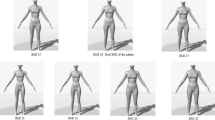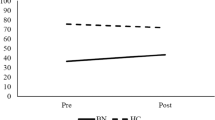Abstract
Cognitive confidence, a type of metacognition referring to confidence in one’s cognitive abilities (e.g., memory, perception, etc.), has been identified as relevant to eating disorders (EDs) using self-report measures. Repeated checking has been found to elicit decreases in perceptual confidence in obsessive compulsive disorder (OCD). The purpose of the present study was to experimentally investigate perceptual confidence, a type of cognitive confidence, in EDs. Specifically, this construct was investigated in the context of body checking, a behaviour with similarities to compulsive checking as observed in OCD. Women with bulimia nervosa (BN; n = 21) and healthy controls (HC; n = 24) participated in the study. There were no group differences with regards to perceptual confidence at baseline F(1, 43) = 0.5, p = 0.48, ηp2 = 0.01, but a significant difference was observed post-checking F(1, 43) = 7.79, p = 0.008, ηp2 = 0.15, which was accounted for by significant decreases in perceptual confidence in the BN group F(1, 43) = 13.31, p < 0.001, ηp2 = 0.24. Similar to compulsive checking in OCD, body checking may paradoxically decrease confidence regarding one’s appearance.
Level of Evidence
Level I, experimental study.


Similar content being viewed by others
References
Cartwright-Hatton S, Wells A (1997) Beliefs about worry and intrusions: the meta-cognitions questionnaire and its correlates. J Anxiety Disord 11:279–296
Hermans D, Engelen Y, Grouwels L, Joos E, Lemmens J, Pieters G (2008) Cognitive confidence in obsessive-compulsive disorder: distrusting perception, attention and memory. Behav Res Ther 46:98–113. https://doi.org/10.1016/j.brat.2007.11.001
Rosen JC (1997) Cognitive behavioural image therapy. In: Garner DM, Garfinkel PE (eds) Handbook of treatment for eating disorders, 2nd edn. Guilford, New York, pp 188–201
Kachani AT, Barroso LP, Brasiliano S, Hochgraf PB, Cordas TA (2014) Body checking and obsessive-compulsive symptoms in Brazilian outpatients with eating disorders. Eat Weight Disord 19:177–182. https://doi.org/10.1007/s40519-014-0111-x
van den Hout M, Engelhard IM, de Boer C, du Bois A, Dek E (2008) Perseverative and compulsive-like staring causes uncertainty about perception. Behav Res Ther 46:1300–1304. https://doi.org/10.1016/j.brat.2008.09.002
van den Hout M, Engelhard IM, Smeets M, Dek ECP, Turksma K, Saric R (2009) Uncertainty about perception and dissociation after compulsive-like staring: time course of effects. Behav Res Ther 47:535–539. https://doi.org/10.1016/j.brat.2009.03.001
Meyer C, McPartlan L, Rawlinson A, Bunting J, Waller G (2011) Body-related behaviours and cognitions: relationship to eating psychopathology in non-clinical women and men. Behav Cogn Psychother 39:591–600. https://doi.org/10.1017/S1352465811000270
Shafran R, Fairburn CG, Robinson P, Lask B (2004) Body checking and its avoidance in eating disorders. Int J Eat Disord 35:93–101. https://doi.org/10.1002/eat.10228
Shafran R, Lee M, Payne E, Fairburn CG (2007) An experimental analysis of body checking. Behav Res Ther 45:113–121. https://doi.org/10.1016/j.brat.2006.01.015
Reas DL, Whisenhunt BL, Netemeyer R, Williamson DA (2002) Development of the body checking questionnaire: a self-report measure of body checking behaviors. Int J Eat Disord 31:324–333. https://doi.org/10.1002/eat.10012
Cooper MJ, Grocutt E, Deepak K, Bailey E (2007) Metacognition in anorexia nervosa, dieting, and non-dieting controls: a preliminary investigation. Br J Clin Psychol 46:113–117. https://doi.org/10.1348/014466S06X11524S
Davenport E, Rushford N, Soon S, McDermott C (2015) Dysfunctional metacognition and drive for thinness in typical and atypical anorexia nervosa. J Eat Disord 3:1–9. https://doi.org/10.1186/s40337-015-0060-4
McDermott CJ, Rushford N (2011) Dysfunctional metacognitions in anorexia nervosa. Eat Weight Disord 16:49–55. https://doi.org/10.1186/s40337-015-0060-4
Olstad S, Solem S, Hjemdal O, Hagen R (2015) Metacognition in eating disorders: comparison of women with eating disorders, self-reported history of eating disorders or psychiatric problems, or healthy controls. Eat Behav 16:17–22. https://doi.org/10.1016/j.eatbeh.2014.10.019
Vann A, Strodl E, Anderson E (2014) The transdiagnostic nature of metacognitions in women with eating disorders. Eat Disord 22:306–320. https://doi.org/10.1080/10640266.2014.890447
Wells A, Cartwright-Hatton S (2004) A short-form of the metacognitions questionnaire: properties of the MCQ-30. Behav Res Ther 42:385–396. https://doi.org/10.1016/S0005-7967(03)00147-5
Kirouac C, Denis I, Fontaine A, Côté S (2006) Questionnaire sur la santé. Montréal, Centre de Recherche Fernand-Seguin. Hôpital Louis-H, Lafontaine
First MB, Spitzer RL, Gibbon MG, Williams JB (1997) Structured clinical interview for DSM-IV axis I DISORDERS (SCID-I). In: Clinician version. American Psychiatric, Washington
Grabill K, Merlo L, Duke D, Harford K, Storch EA (2008) Assessment of obsessive-compulsive disorder: a review. J Anx Disord 22:1–17. https://doi.org/10.1016/j.janxdis.2007.01.012
Fairburn CG, Cooper Z (1993) The eating disorder examination. In: Fairburn CG, Wilson GT (eds) Binge eating: nature, assessment and treatment, 12th edn. Guilford, New York
Rizvi SL, Peterson CB, Crow SJ, Agras WS (2000) Test-retest reliability of the eating disorder examination. Int J Eat Disord 28(200011):311–316. https://doi.org/10.1002/1098-108X28:3%3C311::AID-EAT8%3E3.0.CO;2-K
Smeets E, Tiggeman M, Kemps E, Mills JS, Hollitt S, Roefs A, Jansen A (2011) Body checking induces an attentional bias for body-related cues. Int J Eat Disord 44:50–57. https://doi.org/10.1002/eat.20776
Garner DM, Olmsted MP, Bohr Y, Garfinkel PE (1982) The eating attitudes test: psychometric features and clinical correlates. Psychol Med 12:871–878. https://doi.org/10.1017/S0033291700049163
Groleau P, Steiger H, Bruce K, Israel M, Sycz L, Ouellette AS, Badawi G (2012) Childhood emotional abuse and eating symptoms in bulimic disorders: an examination of possible mediating variables. Int J Eat Disord 45:326–332. https://doi.org/10.1002/eat.20939
Cash TF (2002) The situational inventory of body-image dysphoria: Psychometric evidence and development of a short form. Int J Eat Disord 32:362–366. https://doi.org/10.1002/eat.10100
Cash TF, Fleming EC, Alindogan J, Steadman L, Whitehead A (2002) Beyond body image as a trait: the development and validation of the body image states scale. Eat Disord 10:103–113. https://doi.org/10.1080/10640260290081678
Melnyk SE, Cash TF, Janda LH (2004) Body image ups and downs: Prediction of intra-individual level and variability of women’s daily body image experiences. Body Image 1:225–235. https://doi.org/10.1016/j.bodyim.2004.03.003
Rudiger JA, Cash TF, Roehrig M, Thompson JK (2007) Day-to-day body-image states: prospective predictors of intra-individual level and variability. Body Image 4:1–9. https://doi.org/10.1016/j.bodyim.2006.11.004
Tiggeman M (2001) Person x situation interactions in body dissatisfaction. Int J Eat Disord 29:65–70. https://doi.org/10.1002/1098-108X(200101)29:1%3C65::AID-EAT10%3E3.0.CO;2-Y
Lautenbacher S, Thomas A, Roscher S, Strian F, Pirke KM, Krieg JC (1992) Body size perception and body satisfaction in restrained and unrestrained eaters. Behav Res Ther 30:243–250. https://doi.org/10.1016/0005-7967(92)90070-W
Cash TF, Deagle ED III (1997) The nature and extent of body image disturbances in anorexia nervosa and bulimia nervosa: a meta-analysis. Int J Eat Disord 22:107–125. https://doi.org/10.1002/(SICI)1098-108X(199709)22:2%3C107::AID-EAT1%3E3.3.CO;2-Y
Espeset EMS, Gulliksen KS, Nordbo RHS, Skarderud F, Holte A (2012) Fluctuations of body images in anorexia nervosa: patients’ perceptions of contextual triggers. Clin Psychol Psychother 19:518–530. https://doi.org/10.1002/cpp.760
O’Connor K, Aardema F, Pélissier MC (2005) Beyond reasonable doubt: reasoning processes in obsessive-compulsive and related disorders. Wiley, Chichester
Purcell Lalonde M, O’Connor K (2015) Food for thought: Change in ego-dystonicity and fear of self in bulimia nervosa over the course of inference based treatment. J Psychol Clin Psychiatry 3:1–10. https://doi.org/10.15406/jpcpy.2015.03.00133
Acknowledgements
This research was supported by the Fonds de Recherche du Québec—Santé (#33663) and by the Canadian Institutes of Health Research (#114905). The authors would also like to acknowledge the statistical support provided by Charles-Édouard Giguère, MSc.
Funding
This study was funded by the Fonds de Recherche du Québec—Santé (#33663) and by the Canadian Institutes of Health Research (#114905).
Author information
Authors and Affiliations
Corresponding author
Ethics declarations
Conflict of interest
The authors declare that they have no conflict of interest.
Ethical approval
All procedures performed in this study involving human participants were in accordance with the ethical standards of the institutional research committee and with the 1964 Helsinki declaration and its later amendments or comparable ethical standards. This article does not contain any studies with animals performed by any of the authors.
Informed consent
Informed consent was obtained from all individual participants included in the study.
Rights and permissions
About this article
Cite this article
Wilson, S., Aardema, F. & O’Connor, K. What do I look like? Perceptual confidence in bulimia nervosa. Eat Weight Disord 25, 177–183 (2020). https://doi.org/10.1007/s40519-018-0542-x
Received:
Accepted:
Published:
Issue Date:
DOI: https://doi.org/10.1007/s40519-018-0542-x




